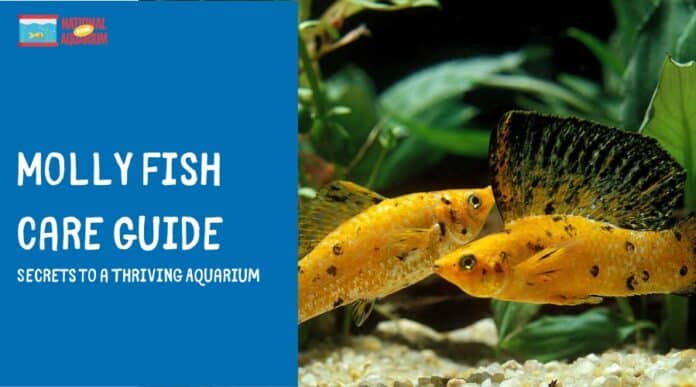Molly fish are a cornerstone of freshwater aquariums and have long been a favorite among hobbyists. These fish are celebrated for their easy-care nature and the broad array of species available.
While their care is generally simple, we always recommend owners to cultivate a comprehensive understanding of this species. This knowledge will ensure your mollies remain content and healthy, and will also save you time in the future.
Our molly fish care guide is a comprehensive resource for beginners. It covers everything from setting up their tank, their diet, lifespan, and even tips on breeding! Plus, we’ve included a list of the most common types of mollies for you to consider.
Information & Overview about Molly Fish
| Scientific name: | Poecilia sphenops |
| Common names | Molly fish, molly, common molly, short-finned molly |
| Distribution: | Central America and southern United States |
| Size: | 3.5–4.5 inches |
| Life expectancy: | 3–5 years |
| Color: | Black, silver, white, red, gold, orange, purple, blue |
| Diet: | Omnivore |
| Temperament: | Peaceful |
| Minimum tank size: | 10 gallons |
| Temperature: | 72–78°F (22–25.5°C) |
| pH: | 7.5–8.5 |
| Hardness: | 15–30 dGH |
| Care level: | Easy |
| Breeding: | Livebearer |
Origin
Molly fish are native to regions of Central America, such as Mexico, and the southern parts of the United States.
These fish flourish in freshwater settings, but they are also frequently found in saltier habitats like lagoons and brackish ditches. Some mollies even inhabit and reproduce in shallow marine environments, such as harbors and areas around mangrove roots.
In the wild, mollies are quite common. The vibrant species of molly fish are typically bred in captivity, while their wild counterparts exhibit a more subdued, silvery-gray hue.
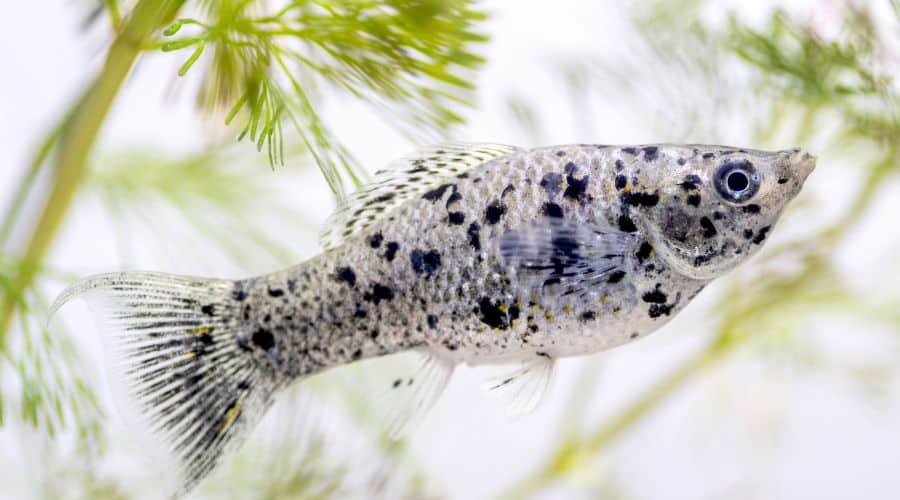
Size & Lifespan
Molly fish, when fully grown, can reach a length of up to 4.5 inches. Females tend to be larger than males, with males typically growing to about 3.5 inches in length. Males also have a slimmer build compared to females, who possess rounder abdomens.
The lifespan of a molly fish can vary based on the specific subspecies. However, on average, both male and female mollies have a life expectancy of between three to five years when kept in captivity.
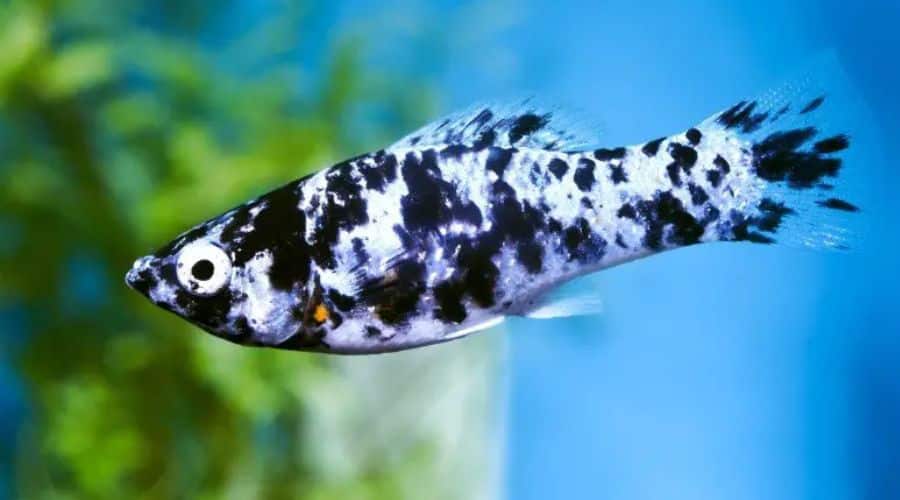
Appearance & Behavior
Molly fish exhibit a diverse range of colors, tail forms, and patterns. The majority of mollies measure between 3.5 and 4.5 inches in length, characterized by their flattened bodies and compact fins.
When kept in a stress-free aquarium environment with non-aggressive companions, mollies are tranquil fish that seldom display any signs of aggression.
Color, Shape, Fins, and Gender Differences
Different types of mollies exhibit unique appearances:
- Black mollies (the most prevalent type of molly fish) possess all-black bodies and rounded fins that range between three and six inches in length.
- Sailfin mollies are characterized by their light gray bodies adorned with rows of dark gray spots and an enlarged dorsal fin that resembles a sail.
- Dalmatian mollies bear a striking resemblance to the Dalmatian dog breed, with their rounded fins and glossy, silver-white scales speckled with black spots.
- Balloon mollies have short, rounded bodies that look like inflated balloons, and they come in a variety of colors including white, silver, black, orange, and yellow.
- Lyretail mollies are distinguished by their caudal fin that tapers into points at the top and bottom, trailing behind the fish as they swim.
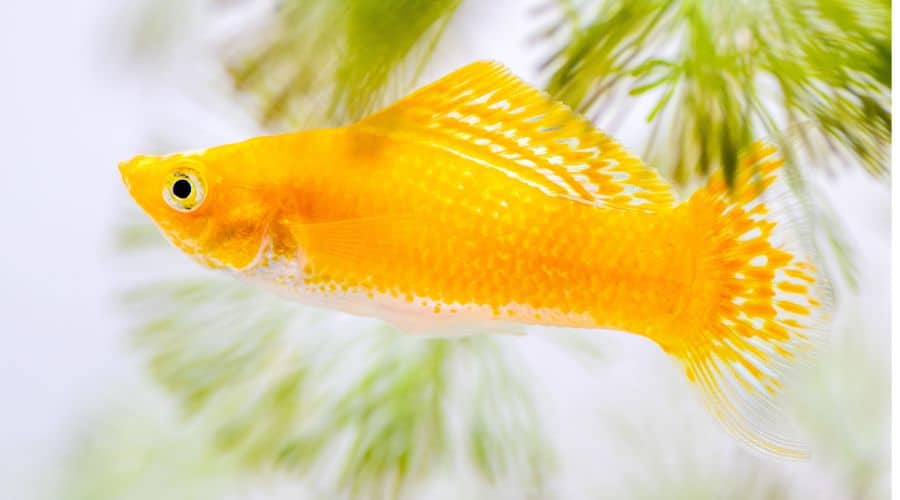
Distinct differences exist between male and female mollies of different types. For example, the anal fin on a male common molly is long and points backward, while the anal fin on a female common molly points downward.
In most types of molly fish, males exhibit bolder and brighter colors than females. Mollies’ colors may fade due to stress, and some molly fish darken or undergo color or pattern changes as they age.
Typical Behavior
Mollies are a peaceful species of fish that generally get along well with others. However, certain factors can trigger aggression in molly fish, such as the presence of aggressive tank mates or overcrowding in the tank.
As social schooling fish, mollies prefer to live in groups of four or more. It’s recommended to have one male molly for every four females in your tank to prevent the males from fighting and asserting dominance.
Mollies are accustomed to living in shallow water, so they tend to swim near the top of the tank. Being shy creatures, mollies appreciate having plenty of hiding spots, like plants and caves, where they can retreat when feeling threatened. Mollies are diurnal, meaning they are most active during the day and rest at night.
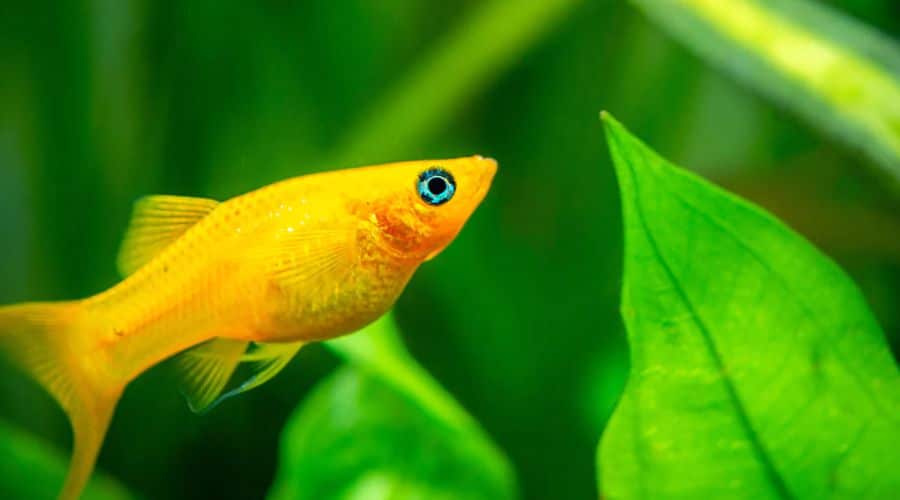
Aquarium Requirements and Molly Fish Care
Setting up the right tank environment for molly fish is straightforward due to their adaptability and resilience. In their natural habitat, molly fish reside in sparsely vegetated, shallow surface waters. It’s recommended to replicate this environment in a freshwater planted tank.
Being omnivores, mollies derive their protein from sources like insects and insect larvae, small fish, and tiny crustaceans. They also have a fondness for plant matter and algae.
Habitat and Tank Requirements
Mollies inhabit a variety of water bodies, including rivers, streams, lakes, swamps, deltas, estuaries, marshes, and shallow surface waters.
Given their adaptability to a wide range of environments, mollies can tolerate broader temperature and pH ranges. Nonetheless, it’s crucial to create an environment that mirrors the molly’s natural habitat to ensure their well-being in captivity.
The presence of foliage in a molly’s tank is essential, and the plants can be secured with a thin layer of sandy substrate. Since mollies don’t spend much time at the bottom of the tank, there’s no need to worry about them disturbing loosely-rooted plants.
Tall plants like Anubias Nana and shorter varieties like Java Fern offer shelter and hiding spots for molly fish. Rocks and caves provide mollies with a refuge if they are being bothered by their tank mates.
While mollies are accustomed to brackish water in the wild, replicating this in captivity can be challenging and may limit the species of fish that can cohabitate with mollies.
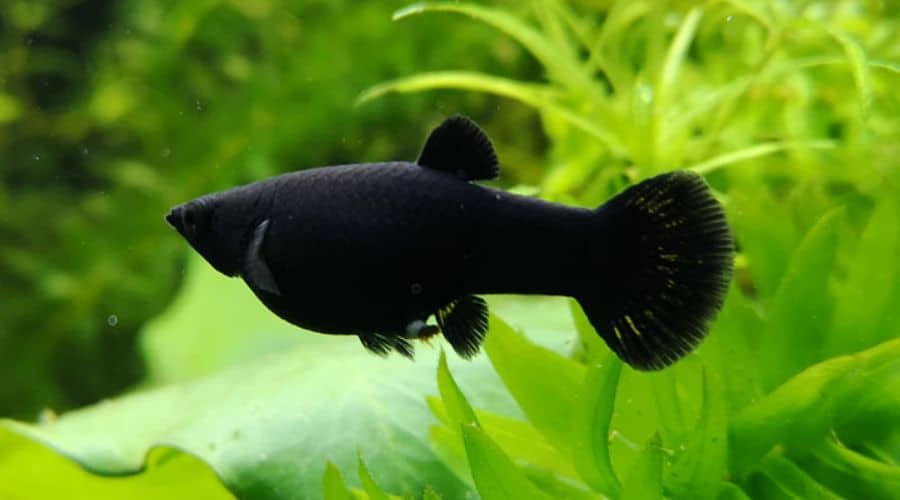
Tank Conditions
The optimal tank conditions for molly fish include:
- Water type: Hard, freshwater
- Tank size: A minimum of 10 gallons for up to four mollies, with an additional 3 gallons required per extra molly fish
- Water temperature: Between 72–78°F
- Substrate: Composed of sand, rocks, and pebbles
- Tank setup: Incorporating plants and caves
- Acidity: A pH level of 6.7–8.5
- Water hardness: 15–30 dkH
- Filter: Necessary for removing excess ammonia, nitrate, and debris
- Bubbler: Essential for oxygenating the water
- Lighting: Not required, unless the aquarium is planted and receives little natural daylight
- Water heater: Needed to mimic the tropical climates that mollies are accustomed to
- Pump: Not necessary, as mollies are used to slow-moving water and don’t require a fast current
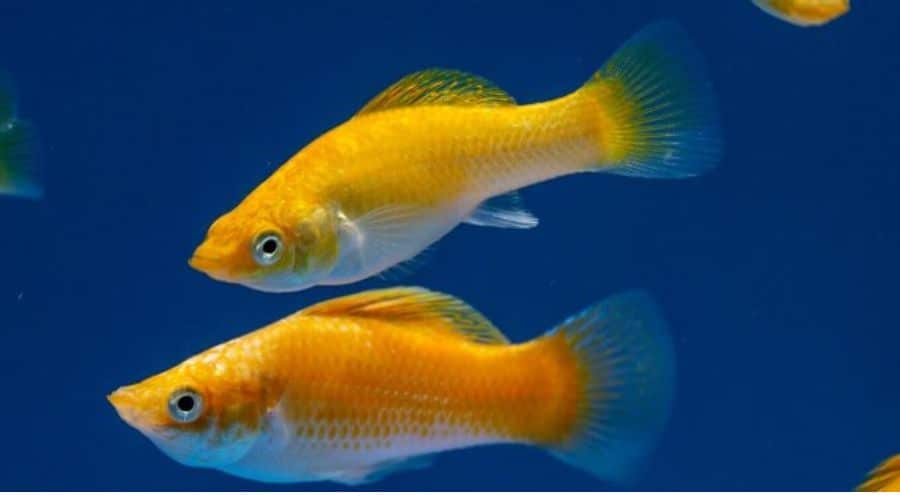
Once you’ve established the right tank conditions for your molly fish, it’s crucial to maintain these conditions. Utilize a thermometer to monitor the water temperature and a pH meter to check the pH level.
Maintaining these water parameters will ensure your mollies thrive in captivity.
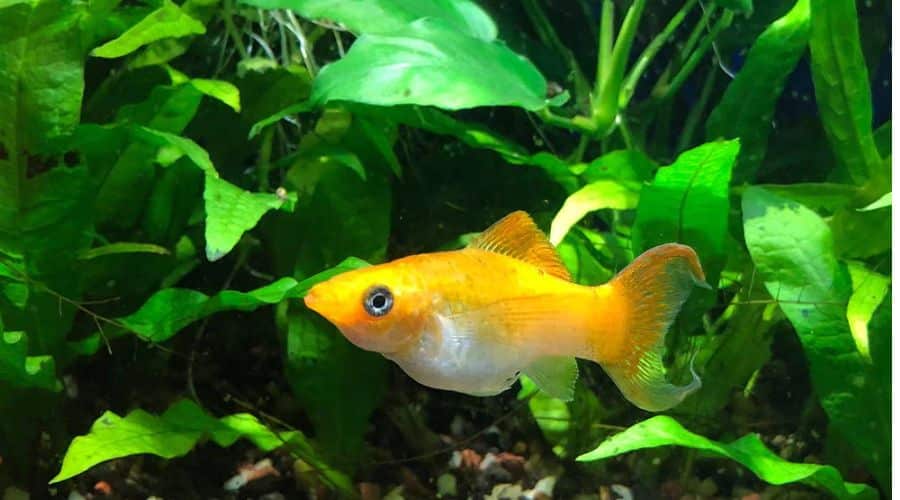
Several common freshwater diseases can affect molly fish in captivity:
Ich
Ich, caused by the protozoan Ichthyophthirius multifiliis, impacts a majority of freshwater fish. This disease manifests as white spots, resembling salt sprinkles, on the fish’s fins, body, and tail. Fish afflicted with ich appear lethargic and frequently rub against rough surfaces.
To treat ich, relocate the affected fish to a quarantine tank, raise the water temperature by two degrees, and add one tablespoon of salt per five gallons of water in the tank.
Velvet
Velvet is another prevalent molly disease, caused by a parasite named Oodinium. This parasite burrows into the fish’s skin, producing gold, rust-like cysts. Molly fish with velvet will dart from one end of the tank to the other, appear lethargic, and rub against rough surfaces.
To treat velvet, turn off the tank’s lights and add copper sulfate, acriflavine, or formalin to the tank as advised by your veterinarian.
Fin and Tail Rot
Long-finned mollies and mollies with fan-like tails are susceptible to developing fin rot and tail rot. This disease results from a bacterial infection due to overcrowding, poor water quality, and stress. A molly fish with fin rot will have frayed, ragged, and milky-colored fins.
To treat fin and tail rot, perform a full water change, and if there’s no improvement in the fish’s symptoms within a week, use antibiotics.
Tank Mates
Mollies are generally peaceful, but they can exhibit signs of aggression when kept in overcrowded tanks or with aggressive tank mates. Therefore, it’s advisable to house molly fish with amicable fish species and provide ample swimming space.
Given that mollies enjoy the company of their own kind, it’s recommended to prioritize purchasing at least four mollies before considering adding different fish to your aquarium.
Ideal tank mates for molly fish include:
- Guppies
- Danios
- Platys
- Gouramis
- Tetras
- Angelfish
- Swordtails
- Certain cichlids (such as dwarf cichlids, keyhole cichlids, and ram cichlids)
Molly fish can also cohabitate with non-fish tank mates, including:
- Snails
- Algae-eating crabs
- Shrimp
Diet and Feeding
In their natural habitat, molly fish consume small invertebrates and plant materials such as algae. It’s recommended to replicate this diet in the tank to ensure your mollies receive the necessary nutrients.
Algae forms a significant part of the molly fish’s diet, and cultivating algae in your tank is an excellent way to provide this food source. If your tank lacks sufficient algae to feed all your fish, consider supplementing their diet with algae wafers. Other plant-based options for molly fish include spinach, lettuce, and zucchini.
In addition to plant matter, incorporate fish flakes and live or frozen foods like bloodworms and brine shrimp into your molly fish’s diet to diversify the nutrients they receive. Rotate between plant matter, fish flakes, and live foods to ensure your mollies obtain all the nutrients they require.
Feed your mollies a small amount of food twice daily. Avoid allowing mollies to eat continuously for more than two minutes as overfeeding can overwhelm their digestive system.
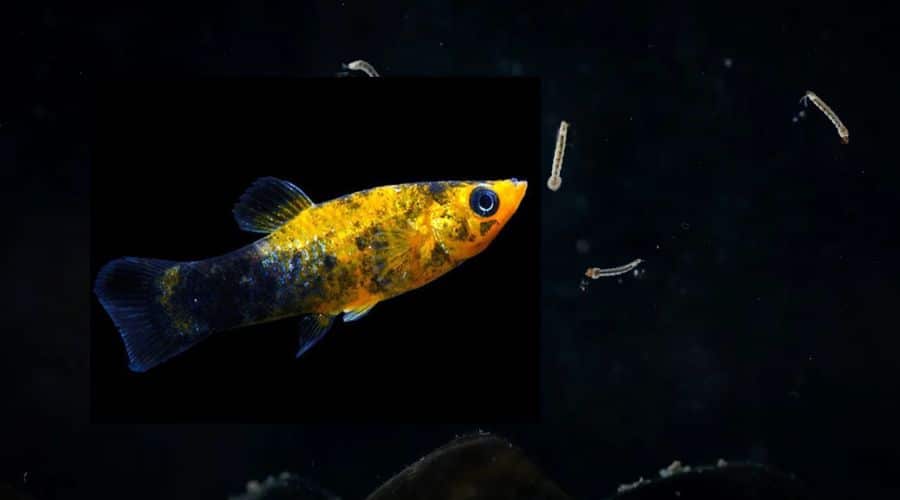
Breeding
Breeding molly fish in captivity is relatively straightforward, making them an excellent choice for those new to fish breeding. Mollies are livebearers, which means that the females carry their eggs internally before giving birth to live offspring.
Here are the steps to breed molly fish:
- Select an appropriate male and female. Female mollies tend to prefer mating with the largest males in the tank.
- Introduce the male and female into a breeding tank with clean water maintained at a temperature of 78°F.
- The male, when ready to mate, will perform a courting display for the female.
- If the female shows no interest in the male after two days, replace the male molly with another.
- If the female is receptive to breeding, the male will fertilize the female by transferring milt into her body using his anal fin, known as a gonopodium.
- Wait for up to 45 days for the female to give birth. Female mollies can give birth to up to 100 juveniles.
- When the female is about to give birth, she will seek out a dark, secluded area of the tank.
- Once the fry have been born, remove the parent fish from the breeding tank and return them to their original tank. This prevents the parents from consuming their offspring.
- Feed the fry powdered fish flakes until they are capable of eating the same food as adult mollies, typically around two months old.
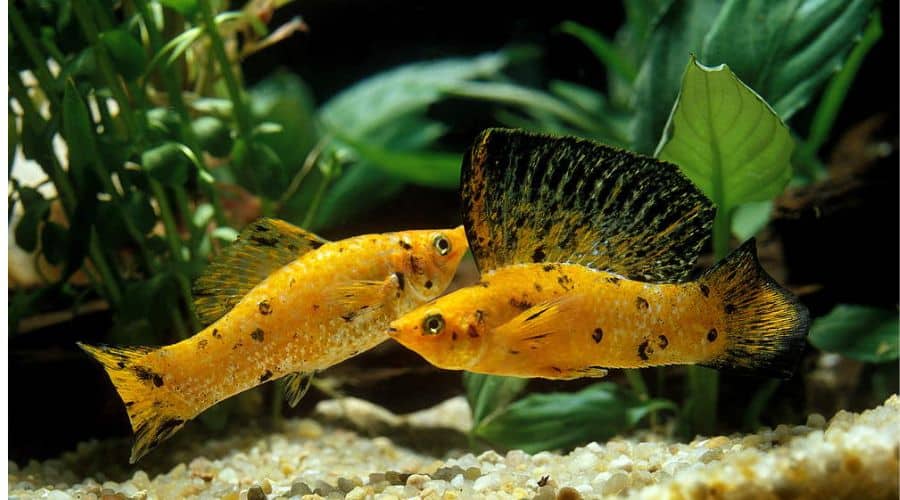
Conclusion
In conclusion, caring for molly fish can be a rewarding experience, offering a vibrant and lively addition to your home aquarium. With the right conditions and care, your mollies can thrive, bringing endless enjoyment. This “Molly Fish Care Guide” is just the beginning. For more insightful and useful information, don’t forget to follow Nationalparkaquarium.org. Dive deeper into the fascinating world of aquariums with us and explore more comprehensive care guides like this one! Happy fishkeeping!

